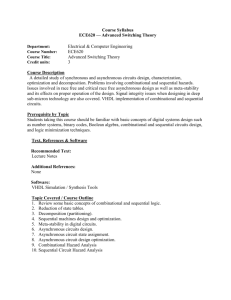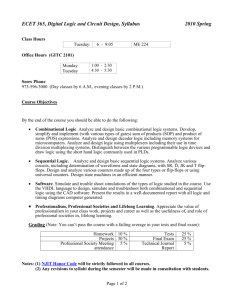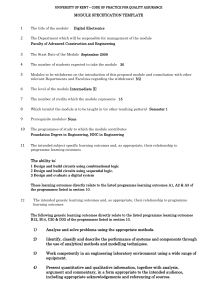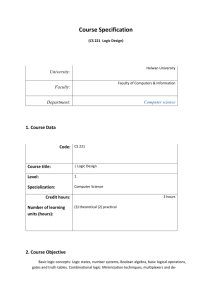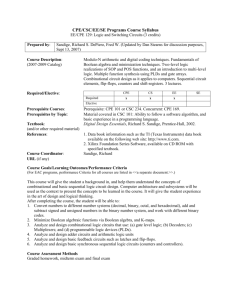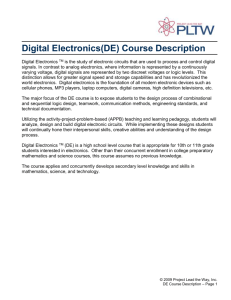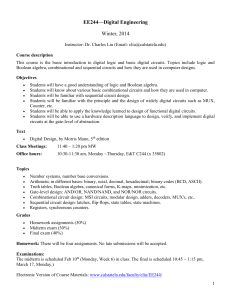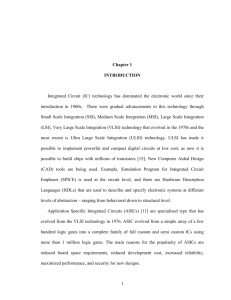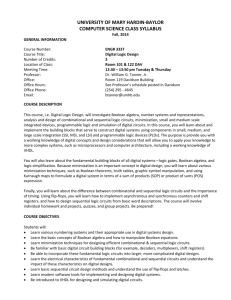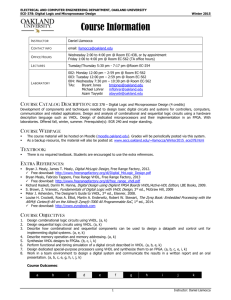sylabus - simonfoucher.com
advertisement
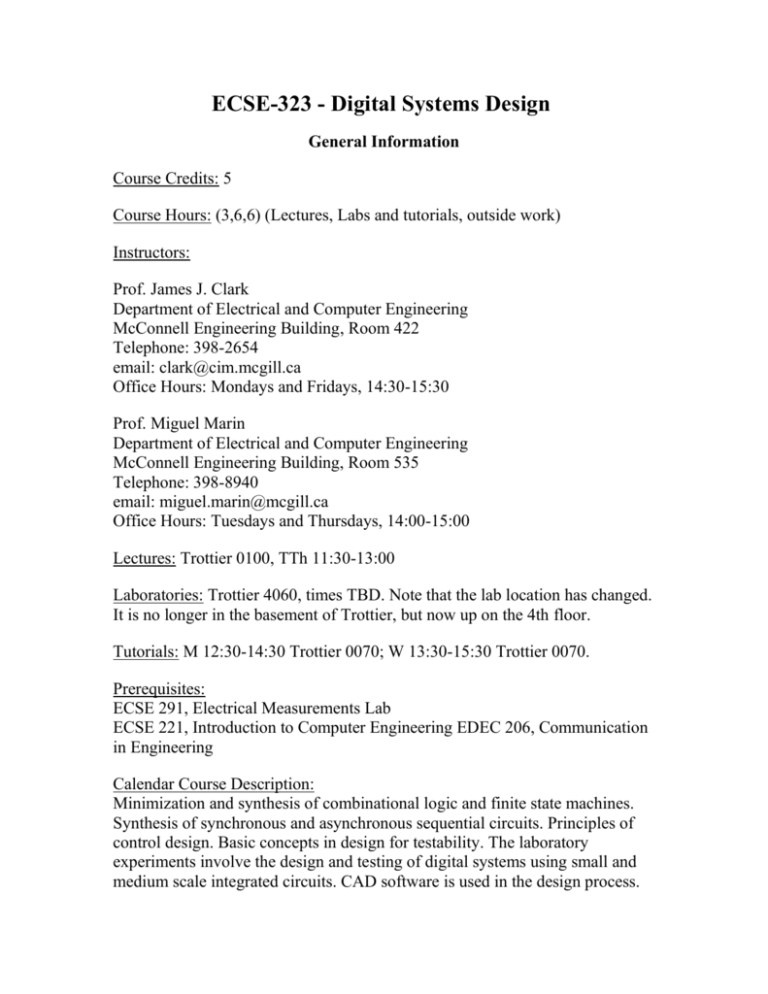
ECSE-323 - Digital Systems Design General Information Course Credits: 5 Course Hours: (3,6,6) (Lectures, Labs and tutorials, outside work) Instructors: Prof. James J. Clark Department of Electrical and Computer Engineering McConnell Engineering Building, Room 422 Telephone: 398-2654 email: clark@cim.mcgill.ca Office Hours: Mondays and Fridays, 14:30-15:30 Prof. Miguel Marin Department of Electrical and Computer Engineering McConnell Engineering Building, Room 535 Telephone: 398-8940 email: miguel.marin@mcgill.ca Office Hours: Tuesdays and Thursdays, 14:00-15:00 Lectures: Trottier 0100, TTh 11:30-13:00 Laboratories: Trottier 4060, times TBD. Note that the lab location has changed. It is no longer in the basement of Trottier, but now up on the 4th floor. Tutorials: M 12:30-14:30 Trottier 0070; W 13:30-15:30 Trottier 0070. Prerequisites: ECSE 291, Electrical Measurements Lab ECSE 221, Introduction to Computer Engineering EDEC 206, Communication in Engineering Calendar Course Description: Minimization and synthesis of combinational logic and finite state machines. Synthesis of synchronous and asynchronous sequential circuits. Principles of control design. Basic concepts in design for testability. The laboratory experiments involve the design and testing of digital systems using small and medium scale integrated circuits. CAD software is used in the design process. Course Learning Outcomes At the completion of this course, students should know the following: CMOS Integrated circuits: The procedure to design fully complementary CMOS complex gates and pass transistor logic. Switching Theory and Combinational Circuit Synthesis: DeMorgan's Theorem, Canonical Forms, Minterm and Maxterm, implicant, prime implicant Quine-McCluskey Method, Two-Level Logic, Petrick functions, Svoboda method, Programmable Logic Devices (PLD): PAL and PLA's, Universal Logic Modules, Field Programmable Gate Arrays (FPGAs), Multi-level Logic, CAD Tools for Multi-level Logic, factoring, decomposition, extraction, substitution and collapsing. Testing of Combinational Circuits: Fault Models. How to generate sets of circuit test inputs using the Exclusive-Or Method and the Path-sensitizing Method. How to derive minimal Fault Detection test Sets (FDTS). Development of Verification strategies. Sequential Logic Design: The design of sequential switching networks. Analysis of cross-coupled NOR gates: using state diagrams in identification of forbidden input conditions. The definition of State, Clock, Setup Time and Hold Time, Latches and flip-flops. Characteristic and excitation equations of flip-flops, and the conversion from one type to another, Timing behaviour of master-slave and edge-triggered flip-flops. Narrow width clocking versus multiphase clocking. Metastability and asynchronous inputs. Counter design: self-starting counters, asynchronous versus synchronous counters. The procedure to design shift register sequence generators. How to analyze asynchronous sequential circuits: fundamental mode; total state, stable state, unstable state; state-transition-table procedure to determine stable and unstable states. Detection of race conditions in counters. Finite State Machines: The definition of Mealy and Moore machines. Construction of state transition tables and diagrams. Algorithmic state machine charts.State minimization using row matching and implication chart methods. State assignment using priority heuristic techniques. Implementation of finite state machines with counters and PALs. Design of Sequential Systems: The Datapath/Controller approach to design of sequential digital systems. Testing of Sequential Systems: How to initialize finite state machines using homing and transfer sequence generation. Scan-path design and testing procedures. Built-in self test techniques using linear feedback shift register based signature analysis and test vector generation. Boundary-scan design. Hardware Description Languages: The basics of event driven simulation via VHDL. Structural vs. behavioural modeling in VHDL. Computer-aided-design tools. Circuit simulation and verification. Using VHDL in designing large scale digital systems. Laboratory: At the completion of this course, students should be able to prototype and test digital systems based on Altera Gate Array integrated circuits. Programming of Altera MAX7000 and FLEX10K programmable logic devices using industry standard software. Use of VHDL to specify and verify combinational and sequential digital circuits of varying levels of complexity. Design and documentation of reusable IP cores and their application to building of complex digital systems. Assumed Knowledge The following knowledge is assumed to have been acquired through previous studies by the student: Basics of Boolean algebra. Function of elementary digital logic gates such as AND, OR, NOT, and flipflops. Use of the Microsoft Windows operating system. Use of Web browsers and search engines. Instructional Method There will be two 1-1/2 hour class lectures every week throughout the term. There will be two 2-hour tutorial sessions each week. Each student is expected to attend one of these two sessions each week. The purpose of the tutorials is threefold: (1) to go over the last assignment and discuss its solution, (2) to answer questions on class related material, (3) to administer an assignment, based on the material of the preceding week's lectures. The assignments will be handed in at the end of the tutorial sessions. The tutorials comprise an important aspect of this course, and each student is expected to attend them. Each instructor will hold two one-hour office hours sessions per week. The purpose of these sessions is to go over class material that students may be having problems with, and also to handle any administrative issues that may arise. The laboratory activity will be divided of five components, each directed towards the completion of the lab project. Each of these lab modules will be carried out over two- or three-week periods. The laboratory is located on the 4th floor of Trottier and will be open every weekday from 9 to 6. If you want to work in the morning and the lab is locked, please ask one of the technicians in the 4th floor shop to open the door. Don't ask the T.A.s to open the door, because they don't have the key! The students will work in groups of two and will be allocated 4 hours of lab per week in two hour blocks of supervised time. Details on the procedure for signing up for your timeslots will be given in the second week of lectures. The lab time should be utilized primarily for testing and demonstration. All the design and assembly should be done outside of regular laboratory hours. Some of the lab experiments will use the Altera DE2 prototyping board. This board contains an Altera Cyclone II 2C20 Field Programmable Gate Array chip along with various LEDs and switches. The lab computers have the Altera Quartus II software installed which allows students to simulate, and download to the development boards, circuits which they have designed. This software is also available in a CD contained in the course textbook, as well as in the DE1 development board kit. The software can also be downloaded from Altera's web site. Course Requirements Required Textbook: Stephen Brown and Zvonko Vranesic, Fundamentals of Digital Logic with VHDL Design 3rd edition, McGraw-Hill, 2008 Information for the course will be posted on the course WebCT web page. The The WebCT page for the course should be the first place you look to get information about the course. Students are expected to use the McGill email facilites for all correspondence with the instructors. The use of email for communication with the instructors or the teaching assistants is encouraged. It is recommended that students provide their return addresses in the message. Often the instructors receive messages asking for information, but the messages do not contain reliable return addresses. Email from free email hosts, such as yahoo or aol is often captured by spam filters and so may not be received by the intended recipient. So, please use your McGill email addresses! Evaluation Procedures The overall course grade will be based on the results of the best 6 assignment grades, one mid-term exam, a final exam, the demonstrations of laboratory experiments, and the documents written for the laboratory experiments. The relative weighting of each of these evaluation components will be as follows: Laboratory Demonstrations 20% Laboratory Documentation 20% (reports for labs 1 to 4 are 3% each, and lab 5's report is worth 8%) Assignments 10% (1.67% each for the top 6 assignment grades) Midterm examination 15% Final examination 35% Grade points for the laboratory demonstrations will be be determined by the fraction of the lab module successfully completed and demonstrated. In addition to the lab demonstrations, each group will be required to submit lab reports for each experiment. It is required that each group develop these documents themselves. Copying is quite easy to detect and will not be tolerated. Offenders will be referred to the Associate Dean of Student Affairs for disciplinary action. Extensions are generally not granted for laboratory demonstrations and module documents. If the midterm is missed due to a medical reason, then the midterm component of the course grade will be added into the final exam component (i.e. the final exam will then be worth 50% of the final course grade). Please note that, in order to get a passing grade (C or higher) for the course, the student must achieve a passing grade in both the lecture component and the lab component of the course. Students who receive a failing grade will be required to repeat the entire course, including the lab, even if they received acceptable grades for one of the course components. Students who do well in the lab part but poorly on the examinations may receive either a D grade or an F grade, depending on how badly they do. Such students will need to repeat the lab, however, even if they receive a D grade. McGill University values academic integrity. Therefore all students must understand the meaning and consequences of cheating, plagiarism and other academic offences under the Code of Student Conduct and Disciplinary Procedures (see Academic Integrity for more information). James Joseph Clark 2008-08-26
